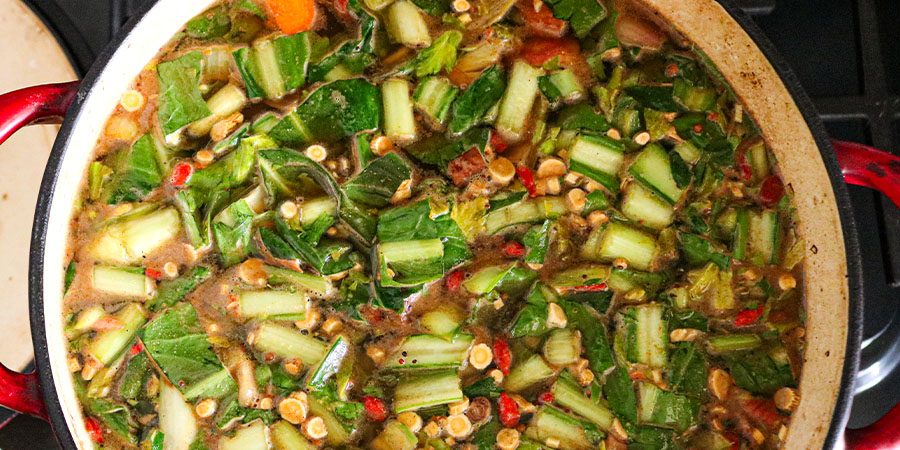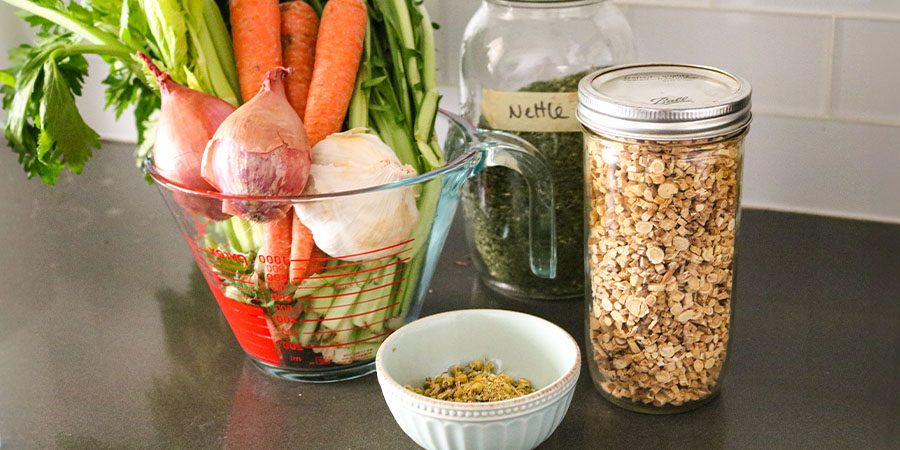Nourishing Spring Greens Broth Recipe
What do you do when you see broth in a recipe? Maybe you’re like me, and you tend to skip it, figuring water and any other spices in the recipe will suffice.
Usually that assumption is fair—if you’re cooking the Ayurvedic way, there’s bound to be plenty of flavor in any dish thanks to the preference for preparing food with herbs and spices to support digestion. But when I take time to include it, broth really does add an extra something.
Rasa is a Sanskrit word used in Ayurveda to mean many things:
- It’s one of the seven dhatus, roughly translated to lymph and other fluids of the body.
- It also means “sap” or “juice,” which includes but extends far beyond these bodily fluids.
- It means “flavor” or “taste.” This includes emotional and mental tastes for things like music, art, and even people.
Broth is associated with all three of these definitions, either nourishing or embodying each type of rasa.
It provides the concentrated flavor and nutritional essence of its ingredients in a form that lends itself to quick absorption by the body. It plumps and fills in spaces when you consume it, rounding out the taste of the foods in your dish and your experience of it on your tongue. It’s satisfying but not in-your-face—something that will enhance whatever your main ingredients are and amplify your taste preferences.

Benefits of Broth
Broth can be especially helpful as part of a healing diet, offering a source of dense nutrition that requires very little work for the body to break down and absorb.
While we typically think of broth as part of a larger dish—the base of a soup or a medium for cooking grains or legumes—it is also a wonderful way to supplement nutrition when drunk on its own.
Broth for Cleansing and Recovery
Sipping broth throughout the day during illness or recovery can be an excellent way to replenish lost fluids, vitamins, minerals, and electrolytes without taxing agni, while also helping to strengthen the digestive fire if it’s been diminished.
In fact, after the potent cleansing of Ayurveda’s traditional panchakarma, variations of broths—rice water, congee, spiced congee—are the main food consumed for several days to restore agni gradually.
They’re especially wonderful for a spring cleanse, where vata and kapha are typically the dominant doshas at play. If you did a double take at that sentence—kapha is abundant in the water element, so why would we add more water?—remember that this isn’t any old water, but broth!
Broth as a Carrier Substance
You can think of broth as an ideal carrier for the particular herbs and spices that we want to increase at the start of spring as the body is dealing with the excess kapha that has built up over the winter. One of the tricks to managing kapha (and any dosha, really), is to disguise the medicine in a form that is similar to itself, making it more readily taken up by the excess dosha.
For instance, we often use honey as an anupan, or carrier substance, for kapha-balancing herbs. The sweetness of the honey delivers these pungent herbs directly to kapha, where they unleash their medicine to melt and break up any excess.
The water element in this spring broth is doing the same thing: delivering pungent and bitter herbs to the system to support the elimination of excess kapha (and ama).
Broth for Proper Hydration
In addition, the water itself is acting on several levels to support proper hydration levels in the body. Consider how smart your body is: if it senses that it’s not getting enough water, then it will tend to hold onto the water it already has, which will stagnate and begin to ferment over time. This manifests in water retention, skin imbalances, lack of vitality, and a boggy digestive state.
If the body is already excessively dry, a different kind of stagnation can occur. Things can’t flow out if there’s nothing to slip and slide, so ama can adhere to the channels like a crust and the bowels will stagnate in the form of difficult bowel movements. If there is any accumulated vata in the system, the broth will re-hydrate and soften the tissues while bringing nourishment and balance.
In either case, adding water to the system helps to keep our internal plumbing working smoothly and supports our overall health and vitality.

A Look at the Ingredients
The ingredients selected for this broth feature the bitter and pungent tastes and offer ideal properties for managing hydration and stoking digestion at the same time.
Bitters
Turmeric Ghee, Dandelion, Fenugreek, Nettles, Chamomile
Beyond their taste profile, which introduce air and space elements into the system (the opposite of kapha), bitters are often used to stoke digestion by increasing hydrochloric acid in the gut, which stimulates salivation and supports agni.
Bitter can also help to slow sugar cravings and tell the body the meal has “ended.” And they are a potent carrier for vata-balancing herbs, here in this recipe to help the body take in the more rasayana (rejuvenating) ingredients for the immune system, kidneys, and bones.
Diuretics and Aquaretics
Dandelion, Nettles, Celery
Since we eliminate excess liquid waste mainly through the kidneys and bladder, diuretics are an excellent category of herbs to support healthy urination and maintain healthy blood pressure. While most prescription and over the counter diuretic drugs will also cause a loss of electrolytes through urine, aquaretics are a special category of herbs that help retain healthy potassium levels.
Immune Support
Mushrooms, Astragalus, Goji Berries
Although mushrooms are considered tamasic in Ayurvedic thinking, traditional and contemporary use prove they’re potent supports for the immune system (and many other systems) when used medicinally.
Astragalus also offers renowned support for the immune system, while goji berries act as a rasayana for the kidneys and adrenals. This natural immune support is especially helpful during seasonal transitions when we’re more prone to imbalance.
All of these ingredients benefit from long, slow cooking in water, making broth the perfect way to consume them.
Minerals
Nettles
Many of us are deficient in minerals like iron, which nettles supply generously. The thing is, you have to consume the actual leaves to get the iron. Here, I’ve added them to the broth after cooking and straining so they steep in a strong overnight infusion.
If you have fresh nettles in season, you can use them instead of the fresh dandelion (or half-and-half!). Cooking them will remove their notorious sting, but be careful to use gloves and protect your skin when harvesting and cleaning fresh nettles.
Prebiotics
Alliums, Spices, Seasonal Vegetables, Ghee
We've all heard of probiotics to support gut health, but prebiotics are where a strong, diverse microbiome begins. Whereas probiotics supply the system with bacteria that might have been depleted, prebiotics offer the soluble fiber that the bacteria eat—so when we consume these fibers, we’re really feeding our microbes more than ourselves!
Using this broth to make legumes, whole grains, or fresh vegetables with peels or skins will add insoluble fiber to the equation, which helps to sweep the gut clean and support elimination.
Alliums provide a well-known prebiotic called inulin, and since our microbiome changes seasonally, any seasonal produce will be supportive for gut health. Plus, beloved ghee is an ideal source of butyrate, a short-chain fatty acid that microbes actually produce as they ferment; so eating ghee is supplementing the microbes’ work.

The Ritual of Cooking Broth
If your mouth isn’t watering for some broth already, here’s one more healing aspect of this incredible super food. All food preparation offers an opportunity to practice mindfulness and gratitude, but there’s something special about big-batch, homemade recipes like this.
Take your time to chop all the ingredients into small, uniform pieces. Add them to the pot one by one. Use your senses to witness the transformation of the herbs while they simmer on your stove and fill your home with scent. When you cook with this kind of presence, it becomes a healing ritual for the soul.
Every time you consume it, then, you’re merging on a spirit level with food that the earth provided for precisely this moment.
Like the water cycle itself, broth is a way to experience the radical, miraculous transformation of matter and energy that’s happening all around us all the time, but especially apparent in the spring. As we watch new life sprout from the earth, we remember our own capacity to expand, flow, and start again.
What better way to celebrate a new season than to participate in this cycle with a warm mug of humble broth?
Spring Greens Broth Recipe
Prep time: 10 minutes
Cook time: 2–4 hours
Makes: 12 cups
Ingredients
- 1 tablespoon Turmeric Ghee
- 2 medium shallots or 1 whole medium leek, chopped
- 3 garlic cloves, crushed
- 2 teaspoons brown mustard seeds
- 2 teaspoons fenugreek seed
- 2 teaspoon ground ginger (or 1 inch fresh ginger, thinly sliced)
- 1 teaspoon ground cinnamon (or 4 cinnamon sticks)
- 1 teaspoon ajwain seed
- 1 teaspoon coriander seed
- 1 teaspoon ground black pepper
- 3 carrots, chopped
- 3 celery stalks, chopped
- ½ bunch fresh dandelion leaves, chopped
- ¼ cup astragalus root (optional)
- ¼ cup reishi, shiitake, cordyceps, or chaga mushroom powder or a handful of dried reishi pieces (optional)
- ¼ cup goji berries (optional)
- 16 cups water
- Juice of 1 lemon
- ¼ cup dried chamomile
- ¼ cup dried nettle
*The recipe is salt-free so that you can add salt as desired if you use the broth for other meals.
Directions
Warm a large pot or Dutch oven over medium heat. Add the ghee, shallots, garlic, mustard seed, fenugreek, ginger, cinnamon, ajwain, coriander, and black pepper. Stir to combine, reduce heat to low, and cook 2–3 minutes or until you hear the seeds pop.
Add the carrots, celery, and dandelion. Stir to coat in the ghee and spices, and cook for another three minutes.
Add the astragalus, mushroom powder, goji berries, and water. Raise the heat to medium-low.
Simmer for 2–4 hours or until the broth has reduced (the longer you cook it, the more it will reduce) and the flavor is rich.
Strain the broth with a large mesh sieve a couple times to remove the solids. I like to use the strainer to scoop out the plant material, then set the strainer in a deep bowl to collect any remaining liquid.
While the broth is still hot, add the nettles and lemon juice directly to the liquid in the pot and stir.
Place the chamomile in a mesh tea ball or reusable tea bag and let steep in the pot for no more than 10 minutes. Remove the chamomile.
Let the broth cool completely before transferring to containers. Use it within one week, or freeze for up to three months.



